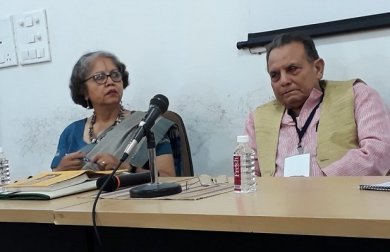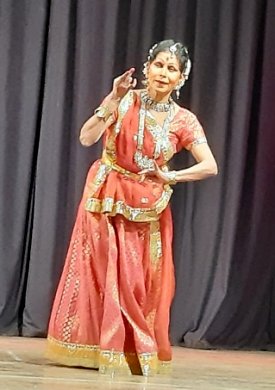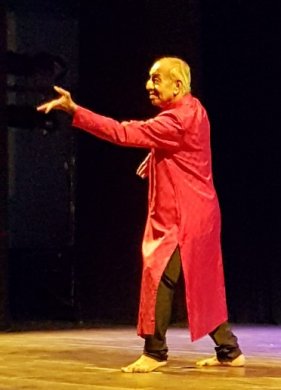
|   |

|   |
Symposium on Transcendence in Dance enriched sensibility - Dr. S.D. Desai e-mail: sureshmrudula@gmail.com February 25, 2019 A shared opinion at the national symposium on Transcendence in Dance Techniques of Embodied Performance (February 8 and 9) organized by the Forum on Contemporary Theory, Vadodara (Convener: Prafulla Kar) with Dr. Parul Shah (former Dean, Faculty of Fine Arts, M.S. University), chief disciple of Anjali Merh, as its Convener was that, like other such symposia do, it enriched and sharpened the sensibility of a creative mind in the sphere of performing arts, particularly dance. 
Parul Shah, Bharat Gupt
Impressions linger in memory. In an atmosphere of interactive cordiality, attention to details and concern for punctuality, the symposium took off on the right note. With scholarly verbal precision in a low profile conversational style, Prafulla Kar in his welcome address linked humanities to performing arts and looked forward to critical reflections and exchange of ideas on embodiment as perceived in dance. In his Key Note address, Bharat Gupt explained treatment of rasanishpatti in Bharata, Shankuk, Bhatta Nayaka and Abhinavagupta and concluded that art leads to self-transcendence. Both the speakers recalled W.B. Yeats' lines on a dancer losing distinction from dance in its culminating moments. The ball was set rolling and one after another the dancer-choreographers, researchers, historians, scholars and rasikas - many of them at a relatively young age having their pursuits rolled into one - made absorbing thirty-minute compact presentations flashing visual images on the screen with the rest seated in a rectangular arrangement turning keen listeners. Having had eighteen speakers to be accommodated in two days, the convener kept check on time with a smile and hand gestures! Brief interventions by way of queries were not unwelcome. Listeners' curiosity matched presenters' passion for work and excitement of sharing details of their creative processes that resulted in embodiment of dance themes. With images of academics often poring over paper to the discomfiture of listeners coming to mind, dance pursuers' articulation with no claims to verbal skills brought a whiff of fresh air. A variety of processes involving painstaking research and an exploratory approach for the creator normally remaining shrouded in mystery for the viewer unfolded. Know and transcend Dance is not about looking pretty, Prathibha Prahlad set the tone in simple words, it is what you convey through dance is what matters. You transcend where you know, she summed up with the key word of the theme at the symposium. Gowri Ramnarayan, who knows both her medium and the message, with verbal and visual illustrations from her acclaimed productions Yashodhara and Sarpa Sutra gave details of her path-breaking creative approach. She blended Dance, Music and Theatre and with a pleasing blend of the three made communication of contemporary relevance. Within the diversity it enjoys, our country in certain parts gives a feel even today of what tradition means to the people that carry it forward. Illustrating with a video clip of a temple ritual, Priti (Patel) Mehrotra, reminded listeners, Manipuri dance is a traditional form of worship and to understand it you need to be part of it. Swarnamalya Ganesh with an element of vivacity in her presentation brought in historical and sociological perspectives to dance practice in India. Even with spirituality ingrained in it, Indian dance has received strong multiple influences even of invading alien forces, she stressed. Rajendra Gangani reminiscent of his and his disciples' energy in Kathak added a modern urban dimension to the discussion when he pointed out that gati in his performances perhaps had germinations in the observation and experience of riding a motorcycle in formative years. 
Shovana Narayan
Veteran dancer-choreographers of different forms have a rich experience to draw from, a sharp mind to comprehend contemporary reality and the ability to interpret myths and literature so as to come to terms with it. Shovana Narayan emerged as a passionate dancer irrepressibly communicative about her evolution as an artist, her themes and her rationale in selecting costumes, music and lights besides the values she holds dear. Likening humans having greed and disregard for environmental wealth to Dushashan, she got into the performance mood with Dhartee ka cheeraharan mat karo... She was on stage (C.C. Mehta Auditorium) on the 9th evening as much with vigorous virtuosity as keenness to link the text with contemporary life. How do others see our dance forms? Italian-born Ileana Citaristi was fascinated by Odissi's powerful physical grammar, learnt it from Guru Kelucharan Mohapatra, became one of its outstanding exponents and went on to win Best Choreography Award in Aparna Sen's Yugant. She has a doctorate in 'Psychoanalysis and Eastern Mythology', is also an exponent of Mayurbhanj Chhau and founder-director of Art Vision in Bhubaneswar. At home, scholars like Arshiya Sethi have had lifetime engagement with significant aspects of dance. Art needs connoisseurs to evaluate it in aesthetic and social perspectives. Her studies in Sattriya dance, on the linkage between bird movement and dance movement and on what she calls 'artivism' remain points of reference. Fresh perspectives One of the major takeaways from the symposium has reassuringly been that some of the young dancers and dance evaluators, including the ones mentioned above, have continually been giving a fresh perspective to our classical dance practice. Neena Prasad, who has expertise in four of our classical dance forms and is a researcher, has had to her credit a remarkable Mohiniattam portrayal of courtesan Amrapali, who puts the country's honour above her love for the neighbouring prince who had conquered Vaishali with bloodshed, refuses to be his queen and finally follows footsteps of the Buddha. Shilpika Bordoloi, a promising young person continually in demand, explores a variety of art forms engaging the eye, the ear and the soul within. She artistically blends her classical skills in Manipuri and Bharatanatyam with slow-motion physical theatre movement anchored with meditational poise and in the process tries to feel, assimilate and become part of the serene bountiful nature in tune with its enchanting sounds, to which she innovatively adds as well. An enlightened spectator herself besides being a Kuchipudi dancer, Madhavi Puranam presented her theory of spectatorship that has details in her book An Analysis of Aesthetics : The Dance, Dancer and the Spectator. An ordinary spectator, she stressed, attains 'aesthetic relish' at a classical dance or music performance through the gradual awakening of the energy centres built into the human body. He has the innate mechanism to understand the universal portrayed by a performer. An ardent spectator-turned-authority on Kerala's performing arts, K.K. Gopalakrishnan responded to the calling from within, called it a day working as an SBI officer and fully devoted himself to their studies, Kathakali and Kutiyattam in particular. To have a firsthand experience of it he underwent the strenuous physical training, now considered cruel, for a Kathakali performance and went on to write his critically acclaimed book Kathakali Dance Theatre. This writer presented 'Embodiment in Dance: A Rasika's Perspective' with the focus on Kumudini Lakhia and Mrinalini Sarabhai's choreographies having a contemporary appeal and presentation aesthetics even as they used the traditional vocabulary of Kathak and Bharatanatyam respectively. 
Astad Deboo
Astad Deboo's presence, participation and performance (Feb 9) was appropriate to the theme of the symposium. His three-segment performance in his signature lyrical slow body movement style was a reminder of the universal acceptance his genre of contemporary dance has been accorded and his evolution as its exponent. One can see the connotative value of his vocabulary in space, enhanced with music and lights. At the same time, as the septuagenarian performer admitted during his participation, there was pressure on the energy and space he uses and the need for stretching and flexibility exercise particularly now. Dr. S.D. Desai, a professor of English, has been a Performing Arts Critic for many years. Among the dance journals he has contributed to are Narthaki, Sruti, Nartanam and Attendance. His books have been published by Gujarat Sahitya Academy, Oxford University Press and Rupa. After 30 years with a national English daily, he is now a freelance art writer. |